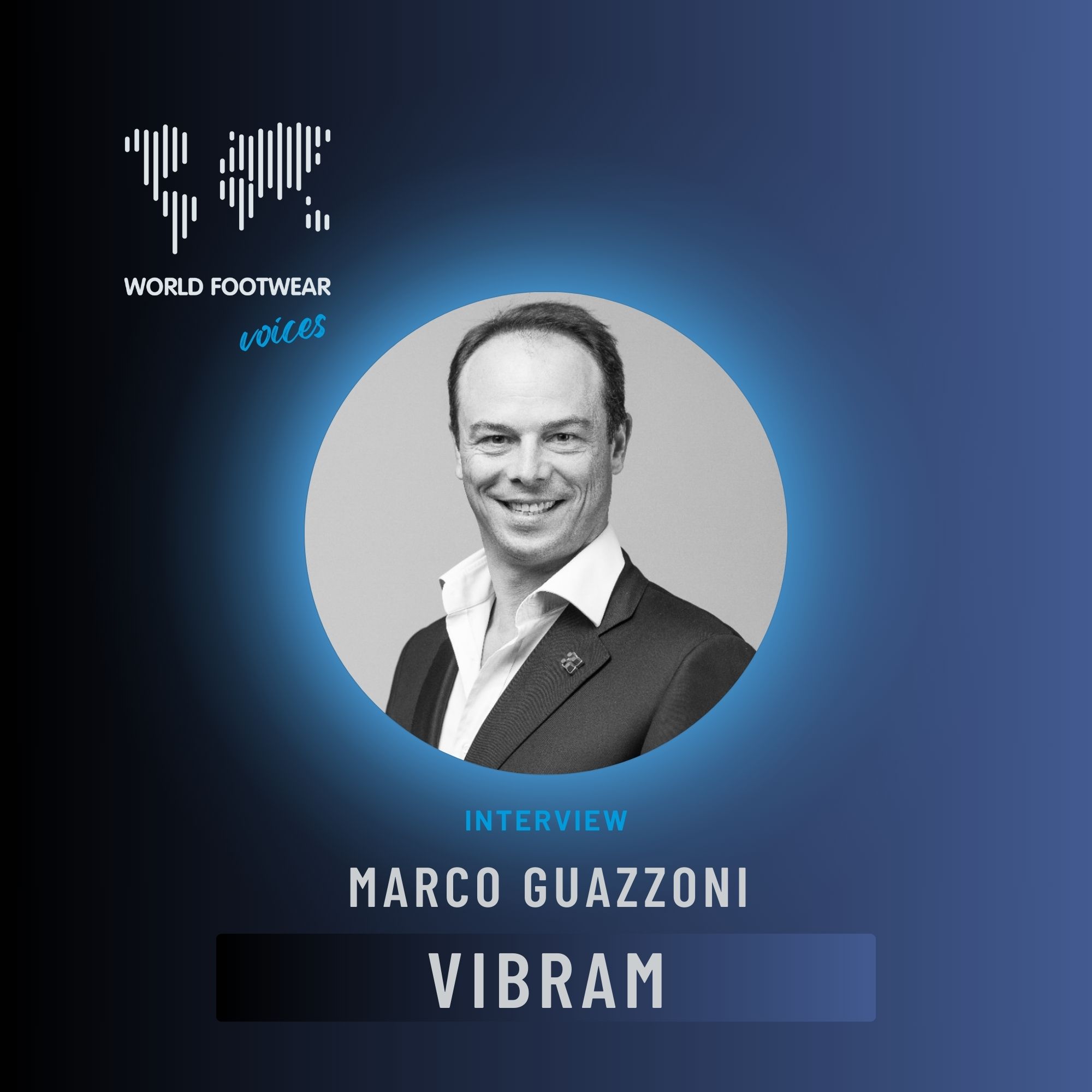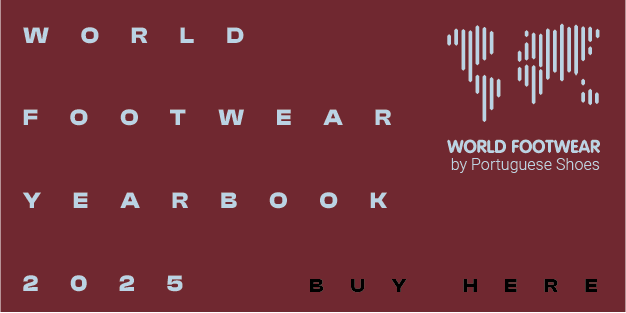Christian Decker (DESMA): New technologies require a mindset shift
During the 22nd UITIC Congress in Shanghai back in September, we had the opportunity to talk with Christian Decker, CEO of DESMA, who shared with us some great insights about technology and innovation. Watch it now
Joana Vaz Teixeira_World Footwear: We are here in Shanghai at the UITIC Congress, and I have with me Christian Decker from Desma. He is the CEO of the company. I will have a nice conversation with him. Christian, thank you very much for being here with us.
Christian Decker_Desma: You are welcome.
Joana Vaz Teixeira_World Footwear: I have a few questions for you. The first one is: if we fast forward to the next decade, what do you think will be the technological breakthroughs that will differentiate Desma from the competition? And can you share with us what you guys are already doing to implement this?
Christian Decker_Desma: Well, (we are working on a lot of) what we heard this morning, I think, a lot about AI (artificial intelligence) and digitization, and also sustainability, and these basic mega trends which are there, not only in the footwear industry but also in other industries. For sure this is also driving us forward. Artificial intelligence from design to manufacturing is really a process where we are focusing, also with partners. We cannot do everything by ourselves. We are always doing this in partnerships, and we have a network of partners where we are doing this together. Also with Nicoline Van Enter, for example which gave today the keynote speech in this morning about artificial intelligence, and this is something in this cooperation we find out that digitization and automation with robotics and all the other processes what we can integrate and also when we heard this morning the guy who gave the opening speech from the CLIA and the professor which gave also a speech that we had the subjects of digitization, material developments, the integration of artificial intelligence, sustainability and everything. When you put all of these in one bag and shake it and this is more or less the content of our developments, of what we are doing today. I think in this network and the partnership with material providers, with automation solution providers, with digitization people, this is really giving us new aspects. We are always reopening our tunnel view more or less every year. Also, the integration with the cooperation of startup companies, which have absolutely fresh ideas. Sometimes some stupid ideas in the first stage, but if you really think about it, then there are really crazy good ideas that can definitely drive our next decade of developments.
Joana Vaz Teixeira_World Footwear: You have a lot of contacts with many companies across different regions, and you see a lot of new ideas coming up, new technologies. From what we are seeing as emerging new technologies, is there anything that you think is going to really be important and critical in the future?
Christian Decker_Desma: Well, I think the main driver of all our developments of the past decades, and it will continue also in the next decade, is (in terms of) material developments. So, it is more or less the chemistry behind, because without the developments of fresh materials, and today we are also talking about mushrooms, for example, as a source for new materials where we then produce a complete shoe out of it. This is something where we are really interested, and this can be the key driver. Besides this, we need artificial intelligence to generate good business concepts out of it. Maybe this is the final stage, but in the first stage, the right chemistry. So a mixture, maybe let's call it like mushrooms plus component A and B, and then suddenly you get out with the right mixture, and this A and B, what you need to develop this is something I think we do really get there only there when we have the right developers, the right education of the chemists, or maybe the material developers, and the right base of artificial intelligence use. So, we need the computerized development of new materials - this is my opinion - and then you are going down really in the molecular structure of new fresh materials, that you can maybe by a finger snip, you can destroy the material again when you firstly want to use your shoe and with any energy source what we are using, then you can, for example, you can delaminate the sole from the upper, you can reuse the upper and you can put underneath a fresh new sole. These components, what we need is now the delaminating part in between the both layers, but also that you can maybe also have a finger snip and you can compose or whatever the complete shoe, and this will be then the generation of the basic for new plants which are then reused for us for food or maybe also to generate a next product. But I think the critical point is all around the material developments.
Joana Vaz Teixeira_World Footwear: We are here at the UITIC Congress, and the theme is about artificial intelligence and how that tool will help companies to be competitive. There are different takes on AI and a lot of people think this is the next big thing, that it is going to be a revolution. In your view, how do you think artificial intelligence will impact the way we are making shoes, the actual production of shoes?
Christian Decker_Desma: Well, people who knew me for years or decades, they know that my main target on top of the line is always speed-to-market, and this always with the target also of sustainability, and also another part is the integration of the consumer in the process chain until you have your product on the table. So, when you just continue the story, what we heard this morning Nicoline Van Enter mentioned this C2C (consumer-to-consumer) market, this is that a consumer can generate a product for another consumer, suddenly you need to rethink completely the business model. What is now the relation of large brands? What is the relation of influencers in the market or whatever YouTubers or maybe any celebrities who are influencing consumption? There, I think really is one key part we need to really reconsider the basic structure of the future and, speed-to-market is my headline and this combined artificial intelligence is the base that any consumer can use it, for design you have seen it, if you just prompt a name: I want to have a new shoe based on a Porsche 911 or a Ferrari Monteverdi or whatever, I do not know exactly, you can just enter this and you get out a sneaker type shoe design influenced by this. What we do not have up to now is really the complete finished process chain. We can generate single steps in the process chain and support them with artificial intelligence. And now it is really the next stages that will be the complete integration from your first idea in your brain until the production of your single pair of shoes, or maybe 100 000 pairs of shoes are done. So, also the preparation of this way, how we are using now artificial intelligence is, in the single steps we are using it already, also for programming, for example robotics, for the contour work on shoes. It is a complex operation, and this is supported by sensorics, and the sensorics is feeding the artificial intelligence and then out of this we are generating the programs for the robots. So, we are doing this job, but the transformation from your shape of the shoe in your computer until you have really the shape of the shoe on the physical shoe on the machinery, this is something where we need also to rethink how we can integrate more artificial intelligence. This is something we are working on it, but it is not finished up to now.
Joana Vaz Teixeira_World Footwear: I think that kind of links to my next question because another topic that we have been hearing about is 3D printing and customization. There has been a discussion about customization and personalization for many years in the footwear industry, and my question for you is: how will or how can Desma kind of fit in this? Is this something that makes sense for your business model?
Christian Decker_Desma: Definitely. We are working… honestly, I am coming originally from the 3D printing industry. I was working as a student at my university at the first 3D printer in Europe. This was 1989. So, it is now 35 years ago. It is crazy that it was 35 years ago and still, we are talking about “3D printing is really the next generation and it will revolutionize everything”. So, even in this not third or a quarter of a century, we have not reached this point where everybody is printing their shoes at home. What we are doing is really the integration of the processes. We are printing shoe lasts, for example, with printers. We have also cooperated with people who are completely 3D printing a complete shoe. And what we like to do is really blend the best components of 3D printed parts into the machinery. Also, we are using 3D printed parts in our machinery. For example, for robotic arms and so on, we are also using their 3D printed components. This is one part. But for the footwear development, I think 3D printing is still too low or too slowly, more or less or for the production not that economic that it makes sense to print a lot of shoes completely 3D. So, I think it will be a stage where we need still 10 or 15 years until we are reaching this point that you can print completely the shoe. What we heard today was interesting. New material developments, there we are back at the materials, blending thermoplastic materials with leather fibers from recycled shoes or maybe handbags or whatever. This may be a concept where we are slowly turning 3D printing into a complete solution to print also the upper part. The sole parts can be printed and there are also some brands in the sport sector that are using this already for mass production, but for our case, we are completely blending 3D printing, and we are also thinking about special 3D printing technologies to implement it into our portfolio more or less.
Joana Vaz Teixeira_World Footwear: Great, a lot of things coming up.
Christian Decker_Desma: Yeah, I am I am quite sure, and excited also of the future.
Joana Vaz Teixeira_World Footwear: Just to finalize, I think when people start to guess what is going to be the factory of the future, I think it is going to be a mix of all these things that we are discussing here. But it is funny that you mentioned that some of the concepts that we are discussing here today as the next big thing are actually things that have been worked and analyzed and studied for many years, decades even. So, the final question is, how do you think it is going to be the factory of the future? I mean, in your view.
Christian Decker_Desma: Honestly, in my mindset, I have this factory of the future, and it has not change since roughly 10 years. So, it is really something that we started already in larger projects with partners when we developed something new. And this factory of the future is more of a small setup, and possibly you can do your design at your home or maybe while you are driving to your office or whatever, and then you are ordering on your smartphone. You are ordering maybe the shoe, and you go around the corner, and you pick it up. Here in China maybe at the 711, which is all around the corner everywhere, and you can pick up your shoe which is printed on demand for you. This is something, the factory of the future is a mixture of a larger factory which is more like a clinical environment, it looks more like a lab but not as an ugly and dirty factory. It is really a clean environment, a silent manufacturing process which is entering in the front there is entering raw materials, and, in the end, there is coming out finished products. But it could be also at your home or maybe around the corner maybe at the fuel station of the future, or maybe also the 711 or the Starbucks coffee around the corner is producing suddenly products for you. This is, it is a mixture. It I cannot say that the factory of the future is having a lot of robots. It can be one piece is just 3D printing and the other piece is a factory full of robots and some humans but we will definitely have always the interaction of humans, and the design and the acceptance of the human is really important. (Also), a consumer trend is (related to) speed-to-market and that means that you can react on changes in weather, or any other conditions. If there is a soccer game here in China in 5 years time of the Dutch team which is coming here, and suddenly orange colored soccer shoes will be printede, for example, for the kids because they are fans of the Dutch soccer. This could be reacted in in some days or even hours you can react on the market trends. This is something what I have in mind. It is not only the factory of the future, is the process chain of the future.
Joana Vaz Teixeira_World Footwear: It brings a lot of challenges for a traditional factory.
Christian Decker_Desma: It is a mindset change.
Joana Vaz Teixeira_World Footwear: It is a mindset. Absolutely. Because I think it is going to raise a lot of questions inside of the factory, because in terms of the distribution maybe the network that we have nowadays is already kind of prepared for that. But I think the big challenge might be there, inside the factory, trying to understand how you can adapt the way you are doing things in a certain way, to certain quantities, to follow certain trends and it is kind of turning the game and doing things in a completely different way.
Christian Decker_Desma: But mainly it is really a mindset change required, and we cannot work in this way traditionally forward as we have done it in the past 40 years, definitely not. And we need all to be open for these new changes in the world of design and the world of computerization and digitization, artificial intelligence.
Joana Vaz Teixeira_World Footwear: Exciting.
Christian Decker_Desma: It is an exciting path in front of us.
Joana Vaz Teixeira_World Footwear: Absolutely. Thank you so much, Christian.
Christian Decker_Desma: Thank you so much.
Joana Vaz Teixeira_World Footwear: This was the interview with Christian Decker from Desma. Thanks for watching.
Christian Decker_Desma: You are welcome.
Joana Vaz Teixeira_World Footwear: I have a few questions for you. The first one is: if we fast forward to the next decade, what do you think will be the technological breakthroughs that will differentiate Desma from the competition? And can you share with us what you guys are already doing to implement this?
Christian Decker_Desma: Well, (we are working on a lot of) what we heard this morning, I think, a lot about AI (artificial intelligence) and digitization, and also sustainability, and these basic mega trends which are there, not only in the footwear industry but also in other industries. For sure this is also driving us forward. Artificial intelligence from design to manufacturing is really a process where we are focusing, also with partners. We cannot do everything by ourselves. We are always doing this in partnerships, and we have a network of partners where we are doing this together. Also with Nicoline Van Enter, for example which gave today the keynote speech in this morning about artificial intelligence, and this is something in this cooperation we find out that digitization and automation with robotics and all the other processes what we can integrate and also when we heard this morning the guy who gave the opening speech from the CLIA and the professor which gave also a speech that we had the subjects of digitization, material developments, the integration of artificial intelligence, sustainability and everything. When you put all of these in one bag and shake it and this is more or less the content of our developments, of what we are doing today. I think in this network and the partnership with material providers, with automation solution providers, with digitization people, this is really giving us new aspects. We are always reopening our tunnel view more or less every year. Also, the integration with the cooperation of startup companies, which have absolutely fresh ideas. Sometimes some stupid ideas in the first stage, but if you really think about it, then there are really crazy good ideas that can definitely drive our next decade of developments.
Joana Vaz Teixeira_World Footwear: You have a lot of contacts with many companies across different regions, and you see a lot of new ideas coming up, new technologies. From what we are seeing as emerging new technologies, is there anything that you think is going to really be important and critical in the future?
Christian Decker_Desma: Well, I think the main driver of all our developments of the past decades, and it will continue also in the next decade, is (in terms of) material developments. So, it is more or less the chemistry behind, because without the developments of fresh materials, and today we are also talking about mushrooms, for example, as a source for new materials where we then produce a complete shoe out of it. This is something where we are really interested, and this can be the key driver. Besides this, we need artificial intelligence to generate good business concepts out of it. Maybe this is the final stage, but in the first stage, the right chemistry. So a mixture, maybe let's call it like mushrooms plus component A and B, and then suddenly you get out with the right mixture, and this A and B, what you need to develop this is something I think we do really get there only there when we have the right developers, the right education of the chemists, or maybe the material developers, and the right base of artificial intelligence use. So, we need the computerized development of new materials - this is my opinion - and then you are going down really in the molecular structure of new fresh materials, that you can maybe by a finger snip, you can destroy the material again when you firstly want to use your shoe and with any energy source what we are using, then you can, for example, you can delaminate the sole from the upper, you can reuse the upper and you can put underneath a fresh new sole. These components, what we need is now the delaminating part in between the both layers, but also that you can maybe also have a finger snip and you can compose or whatever the complete shoe, and this will be then the generation of the basic for new plants which are then reused for us for food or maybe also to generate a next product. But I think the critical point is all around the material developments.
Joana Vaz Teixeira_World Footwear: We are here at the UITIC Congress, and the theme is about artificial intelligence and how that tool will help companies to be competitive. There are different takes on AI and a lot of people think this is the next big thing, that it is going to be a revolution. In your view, how do you think artificial intelligence will impact the way we are making shoes, the actual production of shoes?
Christian Decker_Desma: Well, people who knew me for years or decades, they know that my main target on top of the line is always speed-to-market, and this always with the target also of sustainability, and also another part is the integration of the consumer in the process chain until you have your product on the table. So, when you just continue the story, what we heard this morning Nicoline Van Enter mentioned this C2C (consumer-to-consumer) market, this is that a consumer can generate a product for another consumer, suddenly you need to rethink completely the business model. What is now the relation of large brands? What is the relation of influencers in the market or whatever YouTubers or maybe any celebrities who are influencing consumption? There, I think really is one key part we need to really reconsider the basic structure of the future and, speed-to-market is my headline and this combined artificial intelligence is the base that any consumer can use it, for design you have seen it, if you just prompt a name: I want to have a new shoe based on a Porsche 911 or a Ferrari Monteverdi or whatever, I do not know exactly, you can just enter this and you get out a sneaker type shoe design influenced by this. What we do not have up to now is really the complete finished process chain. We can generate single steps in the process chain and support them with artificial intelligence. And now it is really the next stages that will be the complete integration from your first idea in your brain until the production of your single pair of shoes, or maybe 100 000 pairs of shoes are done. So, also the preparation of this way, how we are using now artificial intelligence is, in the single steps we are using it already, also for programming, for example robotics, for the contour work on shoes. It is a complex operation, and this is supported by sensorics, and the sensorics is feeding the artificial intelligence and then out of this we are generating the programs for the robots. So, we are doing this job, but the transformation from your shape of the shoe in your computer until you have really the shape of the shoe on the physical shoe on the machinery, this is something where we need also to rethink how we can integrate more artificial intelligence. This is something we are working on it, but it is not finished up to now.
Joana Vaz Teixeira_World Footwear: I think that kind of links to my next question because another topic that we have been hearing about is 3D printing and customization. There has been a discussion about customization and personalization for many years in the footwear industry, and my question for you is: how will or how can Desma kind of fit in this? Is this something that makes sense for your business model?
Christian Decker_Desma: Definitely. We are working… honestly, I am coming originally from the 3D printing industry. I was working as a student at my university at the first 3D printer in Europe. This was 1989. So, it is now 35 years ago. It is crazy that it was 35 years ago and still, we are talking about “3D printing is really the next generation and it will revolutionize everything”. So, even in this not third or a quarter of a century, we have not reached this point where everybody is printing their shoes at home. What we are doing is really the integration of the processes. We are printing shoe lasts, for example, with printers. We have also cooperated with people who are completely 3D printing a complete shoe. And what we like to do is really blend the best components of 3D printed parts into the machinery. Also, we are using 3D printed parts in our machinery. For example, for robotic arms and so on, we are also using their 3D printed components. This is one part. But for the footwear development, I think 3D printing is still too low or too slowly, more or less or for the production not that economic that it makes sense to print a lot of shoes completely 3D. So, I think it will be a stage where we need still 10 or 15 years until we are reaching this point that you can print completely the shoe. What we heard today was interesting. New material developments, there we are back at the materials, blending thermoplastic materials with leather fibers from recycled shoes or maybe handbags or whatever. This may be a concept where we are slowly turning 3D printing into a complete solution to print also the upper part. The sole parts can be printed and there are also some brands in the sport sector that are using this already for mass production, but for our case, we are completely blending 3D printing, and we are also thinking about special 3D printing technologies to implement it into our portfolio more or less.
Joana Vaz Teixeira_World Footwear: Great, a lot of things coming up.
Christian Decker_Desma: Yeah, I am I am quite sure, and excited also of the future.
Joana Vaz Teixeira_World Footwear: Just to finalize, I think when people start to guess what is going to be the factory of the future, I think it is going to be a mix of all these things that we are discussing here. But it is funny that you mentioned that some of the concepts that we are discussing here today as the next big thing are actually things that have been worked and analyzed and studied for many years, decades even. So, the final question is, how do you think it is going to be the factory of the future? I mean, in your view.
Christian Decker_Desma: Honestly, in my mindset, I have this factory of the future, and it has not change since roughly 10 years. So, it is really something that we started already in larger projects with partners when we developed something new. And this factory of the future is more of a small setup, and possibly you can do your design at your home or maybe while you are driving to your office or whatever, and then you are ordering on your smartphone. You are ordering maybe the shoe, and you go around the corner, and you pick it up. Here in China maybe at the 711, which is all around the corner everywhere, and you can pick up your shoe which is printed on demand for you. This is something, the factory of the future is a mixture of a larger factory which is more like a clinical environment, it looks more like a lab but not as an ugly and dirty factory. It is really a clean environment, a silent manufacturing process which is entering in the front there is entering raw materials, and, in the end, there is coming out finished products. But it could be also at your home or maybe around the corner maybe at the fuel station of the future, or maybe also the 711 or the Starbucks coffee around the corner is producing suddenly products for you. This is, it is a mixture. It I cannot say that the factory of the future is having a lot of robots. It can be one piece is just 3D printing and the other piece is a factory full of robots and some humans but we will definitely have always the interaction of humans, and the design and the acceptance of the human is really important. (Also), a consumer trend is (related to) speed-to-market and that means that you can react on changes in weather, or any other conditions. If there is a soccer game here in China in 5 years time of the Dutch team which is coming here, and suddenly orange colored soccer shoes will be printede, for example, for the kids because they are fans of the Dutch soccer. This could be reacted in in some days or even hours you can react on the market trends. This is something what I have in mind. It is not only the factory of the future, is the process chain of the future.
Joana Vaz Teixeira_World Footwear: It brings a lot of challenges for a traditional factory.
Christian Decker_Desma: It is a mindset change.
Joana Vaz Teixeira_World Footwear: It is a mindset. Absolutely. Because I think it is going to raise a lot of questions inside of the factory, because in terms of the distribution maybe the network that we have nowadays is already kind of prepared for that. But I think the big challenge might be there, inside the factory, trying to understand how you can adapt the way you are doing things in a certain way, to certain quantities, to follow certain trends and it is kind of turning the game and doing things in a completely different way.
Christian Decker_Desma: But mainly it is really a mindset change required, and we cannot work in this way traditionally forward as we have done it in the past 40 years, definitely not. And we need all to be open for these new changes in the world of design and the world of computerization and digitization, artificial intelligence.
Joana Vaz Teixeira_World Footwear: Exciting.
Christian Decker_Desma: It is an exciting path in front of us.
Joana Vaz Teixeira_World Footwear: Absolutely. Thank you so much, Christian.
Christian Decker_Desma: Thank you so much.
Joana Vaz Teixeira_World Footwear: This was the interview with Christian Decker from Desma. Thanks for watching.

















